I don’t take particular pleasure in writing about politically volatile subjects, but I would be doing a disservice to the readers who count on us to provide thorough overviews of the games we cover if I don’t talk about this aspect of Trails Through Daybreak. This isn’t even the game’s core issue, that would be its unhinged moral relativism, but this particular symptom has greater cultural problems that compel me to do a deep dive on it. I apologize in advance if this essay doesn’t appeal to everybody’s sensibilities (especially since Catholics aren’t the unified political bloc people think we are) and will have curated my words as carefully as possible to avoid offense, but I am a servant of Truth before all else and will not suffer the truth’s obfuscation for the sake of political correctness. I claim no special authority on any particular subject and encourage personal research into these topics. Spoilers for Trails Through Daybreak, Trails from Zero, and the Trails of Cold Steel quadrilogy ahead.
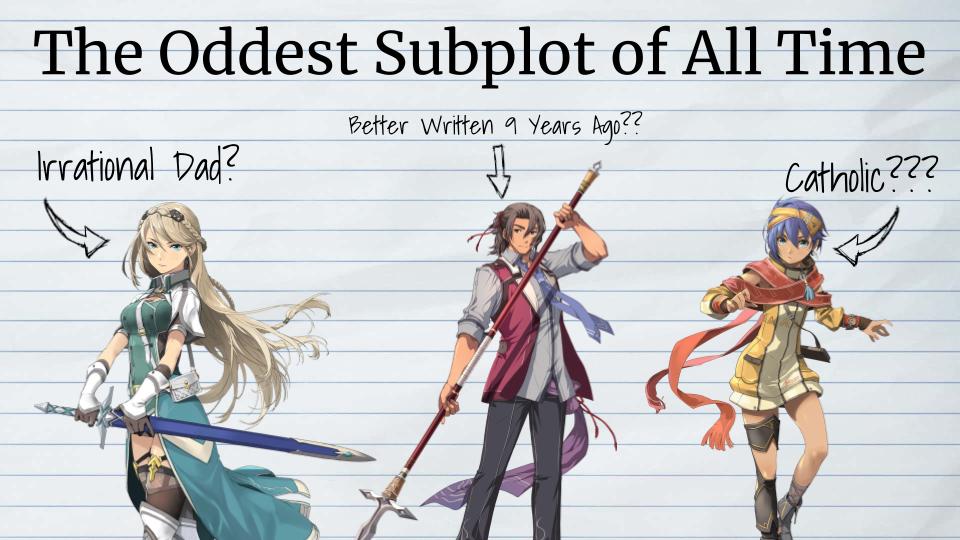
I: Introduction
The Trails series has never been shy about using homages to reality as part of its worldbuilding, and why wouldn’t it when echoes of real places and people give a fantasy world that hint of familiarity which serves as a springboard towards exploring its more personal ideas? You had Crossbell in the Zero and Azure duology for example, which blends New York’s style with Hong Kong’s strained relation with greater powers to help inform its fight for independence. However, part of what makes these inspirations work is that the language of storytelling which these plots engaged with remained firmly rooted in the world of Zemuria, allowing the fantasy to explore its ideas in a way that transcends the particular contexts from which it was drawn and propels it into the realm of the universal.
As I played through the first few chapters of Trails Through Daybreak I was totally ready to afford the game this same grace. I was of course not blind to specific parallels to current events that I discovered early in the game. Though I found them thoroughly frustrating and for lack of a better term “woke,” it’s not like the rest of the series isn’t also quite implicitly left-leaning most of the time and I was perfectly willing to leave my thoughts at “these parallels are kinda wrong and uncomfortable.” But eventually during the car ride on the way to Tharbad, two fateful words were uttered: “white supremacists.” From that point onwards I knew that this was going to be the most difficult review I’ve ever written. A direct link to our real world had been explicitly made, shattering all grace I had given the veil of fantasy, and this needed special addressing.
To recap the subject of this analysis, the country of Calvard is quite obviously based on modern France and America, both in its naming conventions as well as its immigrant influxes and multicultural project, with the latter being the fundamental world building behind all of Calvard’s characterization. The desertification in Eastern Zemuria has led to a significant movement of Easterners and Central Easterners into Calvard, and while most of Calvard’s population has been on board with welcoming their new neighbors, a subset of the population is against their immigration. This difference of opinion sets up these “white supremacists” as an animating force behind the terror attacks which take place in the game, if only indirectly via providing funding to Almata, and are addressed slightly more directly in Chapter 5 of the story. That’s basically the gist of their involvement in the plot.
It doesn’t take a genius to understand where the parallels to reality lie, specifically with the native Calvardians being nods to the French and the Central Easterners being somewhat similar to middle eastern immigrants. What of course disturbed me right away was the fact that basically none of this cleanly tracks to reality. The Central Easterners and the Easterners of Zemuria are shown to slot right into the Republic with no trace of evidence to suggest they were actively harming the country aside from the fact that the Easterners brought the Heiyue crime syndicate with them (albeit Trails has a really stupid problem of treating Heiyue like they’re basically a benign force, pardon me for being skeptical). Meanwhile in real-life France there are horror stories coming out of the cities about how women don’t feel safe to go outside anymore because the streets are occupied by dangerous young foreign men who weren’t brought up with the same egalitarian values that the west broadly has (among other reports). This game was released within days of a French surprise legislative election where riots took place and the elite class manipulated the vote in order to block representatives from winning offices… and it was the pro-immigration faction that facilitated both. That is supremely unfortunate timing at best and utterly tone-deaf at worst. Up until Chapter 3 though, I was completely willing to allow this as an ill-timed blunder and simply accept Calvard as depicting a world where these political assumptions of the western left-wing were true. I was ready to engage with the fiction on its own terms. But the minute they used the term ‘white’ specifically, in a game where every other ethnic group is afforded a layer of linguistic separation, I became determined to analyze this aspect of the story thoroughly and find out just how “mature” this new chapter of the Trails saga really was.
Before I go any further I need to address that specific term ‘white supremacist’ and why it is the driving force behind my work here. White supremacy historically refers to a racist mindset that believes people of European descent are inherently superior to those in other ethnicities. This of course is an absolutely stupid and awful idea, and the Church herself has condemned the idea of racism in every form it takes. Pope Pius XI addressed this in paragraph eight of Mir Brennender Sorge, and considering this is an official Church document with a German title from the latter-1930s you can probably guess who it was directed at:
Whoever exalts race, or the people, or the State, or a particular form of State, or the depositories of power, or any other fundamental value of the human community – however necessary and honorable be their function in worldly things – whoever raises these notions above their standard value and divinizes them to an idolatrous level, distorts and perverts an order of the world planned and created by God; he is far from the true faith in God and from the concept of life which that faith upholds.
I have absolutely no reason to defend white supremacy, especially because Catholics are almost always targeted by major supremacist movements, and I implore you to reject it in kind. It has to be understood however that the ‘white supremacy’ spoken of in modern American politics (which have a massive influence on western discourse as a whole), while certainly still applying to the true white supremacists that remain, is far, FAR more often used to slander people of European descent with conservative beliefs directed towards the preservation of their own culture. It cannot be emphasized enough that in truth many defend their culture not because western culture is inherently superior but because it, like the vast majority of cultures, has many positive aspects which deserve to survive the same as the others. If anything, associating white people championing the wrong politics with white supremacy has itself mutated into a new bigoted sentiment of “all white people are racist,” perpetuated by unethical academic theories such as Critical Race Theory. This modern definition of white supremacy is unfortunately what Trails Through Daybreak has more in common with. It’s a bit of a bold claim to be sure, but Chapter 5 holds a huge wealth of material which backs up this observation.
II: The Many Farces of Chapter 5
The first observation I made in Chapter 5 was that racist sentiments exist exclusively within the old money upper class of the former capital city of Oración, the last major remnant of the old kingdom which the current republic overthrew, immediately associating the term purely with white people trying to hold onto the past. This is probably the most overtly propagandistic part of their depiction, as if it were true that the core of the white supremacists were affluent then we would expect their beliefs and values to be disseminated among the other social classes in cities across the nation via astroturfing. Perhaps we could say this is one value the populace is just fortunately resistant to accepting, but in practice having the prejudice concentrated in an upper class setting in one city comes across as an attempt to pander to our sense of envy. It also keeps the rest of Calvard’s population conveniently clean even though it would make sense to run into racists in other places like Edith. The game does explain that Calvardians in general have been abandoning supremacist attitudes, and I will grant that the same can mostly be said of the real world too so that isn’t a problem. But in the real world the remnants of white supremacy are not concentrated in any particular city or social class, and that Daybreak should choose not to portray that aspect really bothers me and exudes inauthenticity.
The nature of this ‘white supremacy’ having more to do with an attack on conservatism rather than genuine race relations became most apparent to me when I triggered a conversation about a formerly royalist newspaper operating in the city, which Van roughly commented: “… is conservative, but at least doesn’t publish anything openly racist.” The wording of ‘openly’ suggests that Van and the other protagonists implicitly assume, or at least brace for, racism from a white person with conservative leanings or backgrounds. This prejudice goes on full display when they accept a 4SPG from an immigrant girl who was sent a threatening letter. When the girl suggests it may have been a standoffish classmate of noble descent who would stand to benefit from her compliance, the party immediately says in chorus that the classmate is suspicious based on that information alone and storms off to question her. While the party does obviously realize that this classmate is innocent after talking to her for a while and uses that information to catch the real culprit, at no point do they ever stop to reflect on the fact that they themselves committed the act of judging someone by their blood. What happened to Aaron’s “I can’t stand stereotypes” declaration?! That would have been the perfect moment to say ‘hey this seems like too easy an assumption to make’ and show that the game is at least aware of how it chooses to treat this subject.
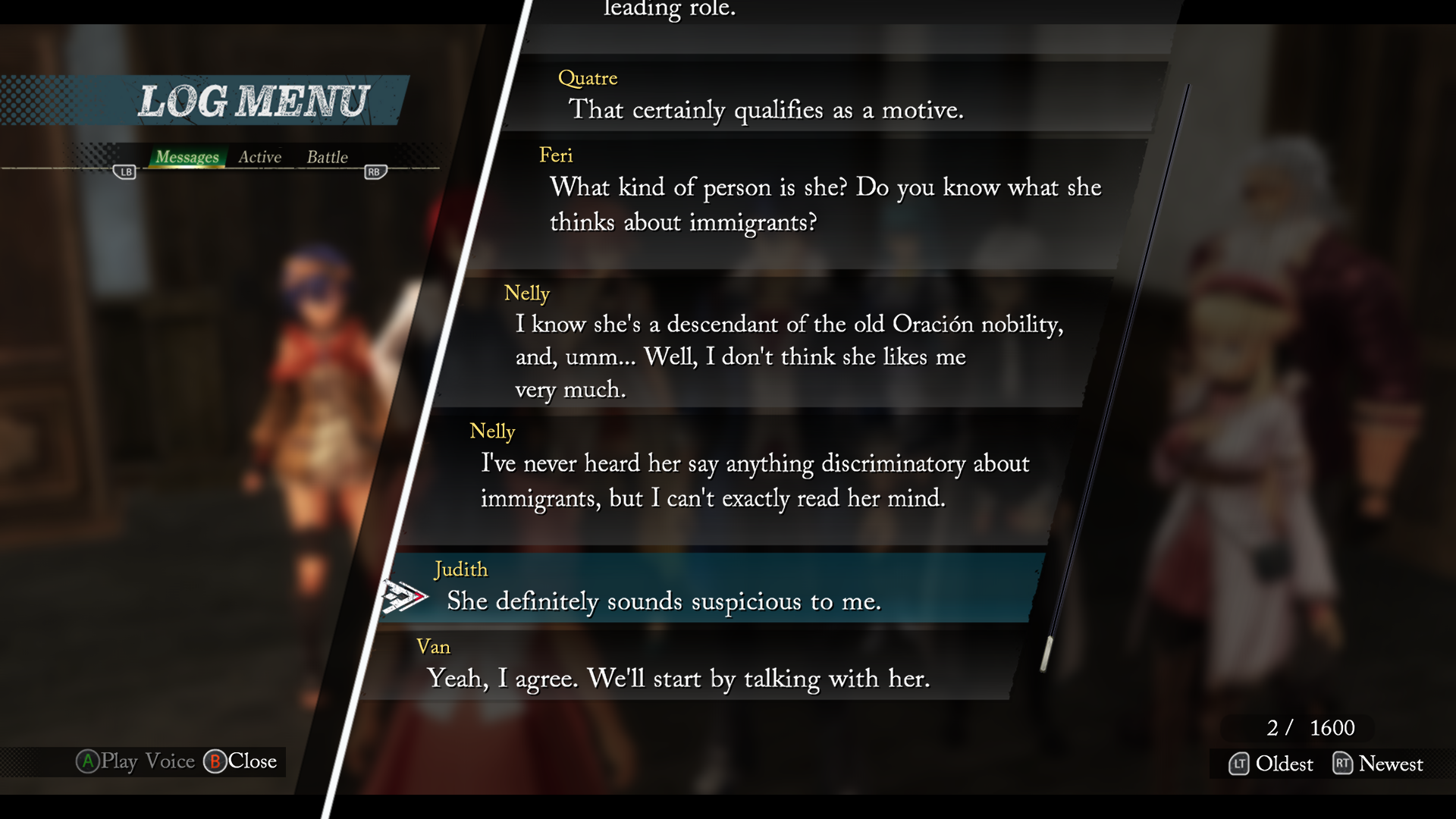
It thus seems quite clear that the game’s depiction of “white supremacy” is deeply tied to the demonization of whites trying to conserve their pasts, even if you have to run into a few optional dialogues to grasp the full picture (a problem for this subplot as a whole to be honest). However, for the sake of argument let us assume that these connections may be coincidence and focus on the main story, truly trying to see what it wants to say about white supremacy in the classical sense. The supremacists are in fact written to be genuinely racist after all, unhelpful as I find it in light of the “racist whites” stereotype. Is Trails Through Daybreak’s discussion of the phenomenon nuanced and thought out, or ham-fisted and sloppy? What reasons inform these villains’ beliefs and actions? Unfortunately aside from some very trite remarks about “immigrants taking our jobs” which isn’t given any time to be expanded upon, the only possible reason we could extrapolate from is that of Edmond Auclair, the only white supremacist given any dialogue in the main story (barely). And his reason for supporting these efforts is to… reinstate the monarchy. This is absolutely absurd for many reasons if we accept this as the fundamental driving force. Given that these characters live in a situation where the immigrants are mostly harmless and even beneficial to Calvard, the former nobles have no reason to target them specifically and should instead focus on finding ways to undermine the legitimacy of the republic if they are actually serious about accomplishing their goal. It’s not as though the immigrants are depicted as having high levels of representation in the government anyways, so they shouldn’t even be in the crosshairs aside from maybe Heiyue. And that wouldn’t even require playing the race card to gather support for, because Heiyue is a literal criminal organization that they have every right to try to drive out.
And on the subject of the immigration itself, it has been well established that the desertification of Eastern Zemuria is the driving force behind it, but the issue is that the desertification only started in the last few decades. This means the whole bit about the Calvardian Revolution fighting for racial justice is quite literally around 60 to 70 years too removed for it to actually have been a major factor. We’re never told about immigration that happened during the kingdom era as far as I know, so the supremacists’ energies are even more stupidly misdirected, and the provisions in the Calvardian Constitution regarding ethnic non-discrimination are drafted too early. At most the tolerance probably would have been an unspoken rule to be enshrined later once it actually became a relevant issue, but the idea they divined the relevance of that clause over half a century out is wonderous indeed. It’s even directly stated that the problems with the monarchy which led to the Revolution were famine and iron-fistedness on the part of the royals, not racism. At this point I’m not even asking Trails Through Daybreak to get its politics straight, I’m literally asking it to make its own lore make sense! I have never wished for an in-game library with historical records so much, but I guess movie brochures are just too important. The only option we are left with is to just cast Edmond and the other supremacists as brain dead, but considering Edmond runs a successful business and raised the highly competent Elaine Auclair I highly doubt this to be the case.
The actual white supremacists are not given anywhere near enough screen time to possibly delve into a more thoughtful discussion, one about what would drive a person to hold such terrible views and how to change their minds or otherwise counter them. Furthermore the time one of them does get on screen only serves to make the worldbuilding feel haphazard, and this cements the lot of them as a presence that feels fake. They’re as forced as the heavy-handed use of the real-world term ‘white’ would have you believe, and exist to be nothing more than another group of cartoonishly evil villains to make Arkride Solutions look more heroic than they otherwise would appear. While some would argue that the likes of white supremacists don’t deserve the kind of exploration I am suggesting, that very unwillingness to explore their circumstances is exactly the sort of dangerous, immature behavior that leads to the strife this whole issue is trying to address. It makes us no different from the racists who refuse to understand the people they hate, and it’s what ultimately makes the political messaging of Daybreak so toxic. Anyone can write a story where a particular group is nothing but evil, but it takes maturity to write a story that strives to understand all parties involved.
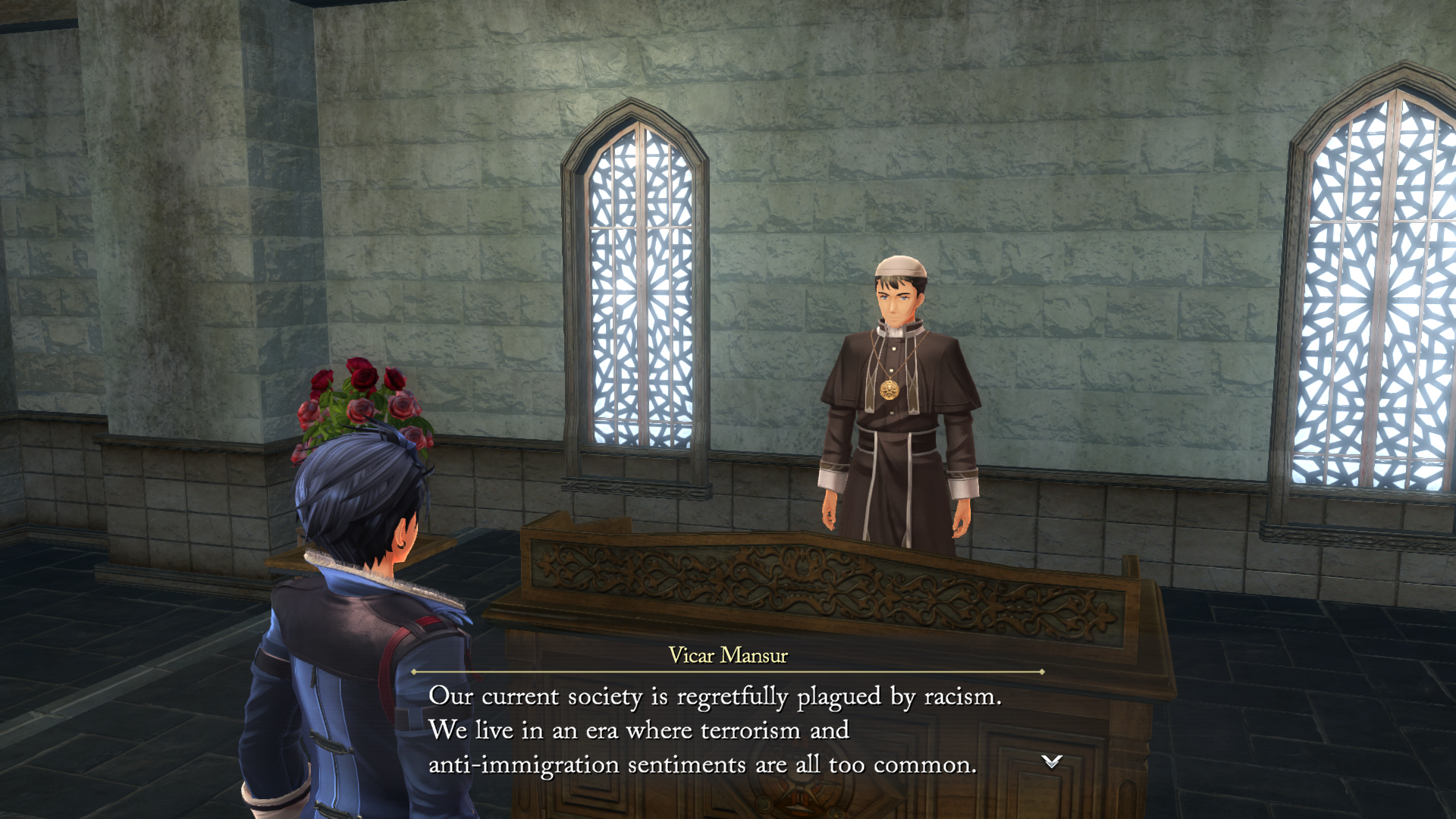
The short title of this essay is La Oracionese, which players of the game may recognize as the name of an in-universe song, and the choice was very deliberate on my part. La Oracionese was popularly sung around the time of Calvard’s revolution, and very nearly became its national anthem. However, despite being a pro-revolutionary song it was ultimately rejected because some of the lyrics lamented the fall of the monarchy, and I couldn’t help finding this detail to be deeply profound. The very existence of this song is a hint that the popular conscience of the revolutionary Calvardians contained in itself a love for their country that left them sorrowed that revolt was their only recourse. But for that to make sense there must have been something in the culture of the Kingdom of Calvard that would cause them to lament the end of the old regime even as they stained their hands with the blood of the royals. In other words, there’s a deeper story to the Calvardian Revolution that is far more tragic and recognizes the full truth of the matter they could have passed down, but ultimately they decided to kill their own feelings and forever willfully remember the kingdom as nothing but wretchedness. The same can truly be said of Trails Through Daybreak, as while it need not have nor should have entertained the idea that racism is good, there was a possible mature story which still could have had the grace to humanize its antagonists in the same way the series as a whole humanizes many of its big bads (even bloody Almata, the mafia psychopath nuclear terrorists in the same story, get more grace), but they chose the easy path of caricature in the end.
III: Breaking What Didn’t Need Fixing
This is not the mature writing we were promised, and we deserve better. Falcom owes us better, and I know that they can do better because they already made a series of games that tackles difficult political themes in a healthy, mature, and constructive way, and it’s called Trails of Cold Steel. This arc makes it very clear in the beginning that the conflict between the noble and reformist factions of the Erebonian Empire is going to be a central part of the story, but despite these political themes the game makes it abundantly clear that its purpose is NOT to demonize anybody. Class VII itself is the living embodiment of this, a small-scale gathering of nobles and commoners alike which is intended to help the younger generation bridge the gap between them and lead their country into the future through bonds of philia. There is no member of Class VII that isn’t given context regarding why they behave as they do, and the story uses their circumstances as a chance for them to reflect and grow. Even beyond Class VII itself there are major characters like Patrick Hyarms, a character whose presence in the story served initially as the arc’s direct criticism of the nobility, who develops over time to the point where he legitimately undergoes change and becomes one of Rean’s closest allies come the second half of the journey. And though the Cold Steel series is broadly speaking in favor of the reformists, it even has the sense to show both sides having their positives as well as being capable of the same terrible things. The noble alliance may have started a civil war that threatened the Empire, but Osborne and his supporters started an international war which threatened the end of the world. I don’t even agree on a personal level with the games siding more with the reformists, but I don’t mind the politics of Cold Steel because they are presented in a manner which is conducive to human peace and flourishing if you follow their example.
One might object to the comparisons I’m making here by claiming that racism and class conflict aren’t similar enough, and I do realize that unlike the nobles and reformists you’d want the supremacists to be fully reformed from their previous attitudes as opposed to simply correcting their excesses, but Cold Steel does also engage with prejudiced sentiments during brief sections of the narrative and does it leagues better than Daybreak. During the beginning of Cold Steel’s Chapter 3 the aforementioned Patrick finds himself going through arguably his lowest point as a character, just absolutely railing against the commoners and the members of Class VII for their supposed inferiority to himself. He even calls the foreign exchange student and best boy Gaius Worzel, to paraphrase, a barbarian who he’s surprised could even read the enrollment forms. These remarks are indeed so heinous that even his fellow Class I friends start to take issue, and at this point Gaius has every right to respond with furious indignation. But what does Gaius do? He steps forward, calmly asks Patrick to explain what truly makes nobles better than commoners, agrees with the importance of the many things the nobles value (tradition, dignity, grace, pride, etc.), and then challenges Patrick to figure out where those nasty remarks fit into all of that, which Patrick can’t answer. Gaius is not there to antagonize but to understand, and by sticking to that mission he is able to make Patrick self-contradict. Absolutely brilliant stuff, and it’s not even the only content in the quadrilogy with related themes, albeit the other examples are much more subtle. Understanding a hostile point of view doesn’t always mean coming to agree with it, indeed with understanding can come all the more reason to disagree and insist upon change, but it is something to strive for in all cases. Trails Through Daybreak. Has. NO. Excuses.
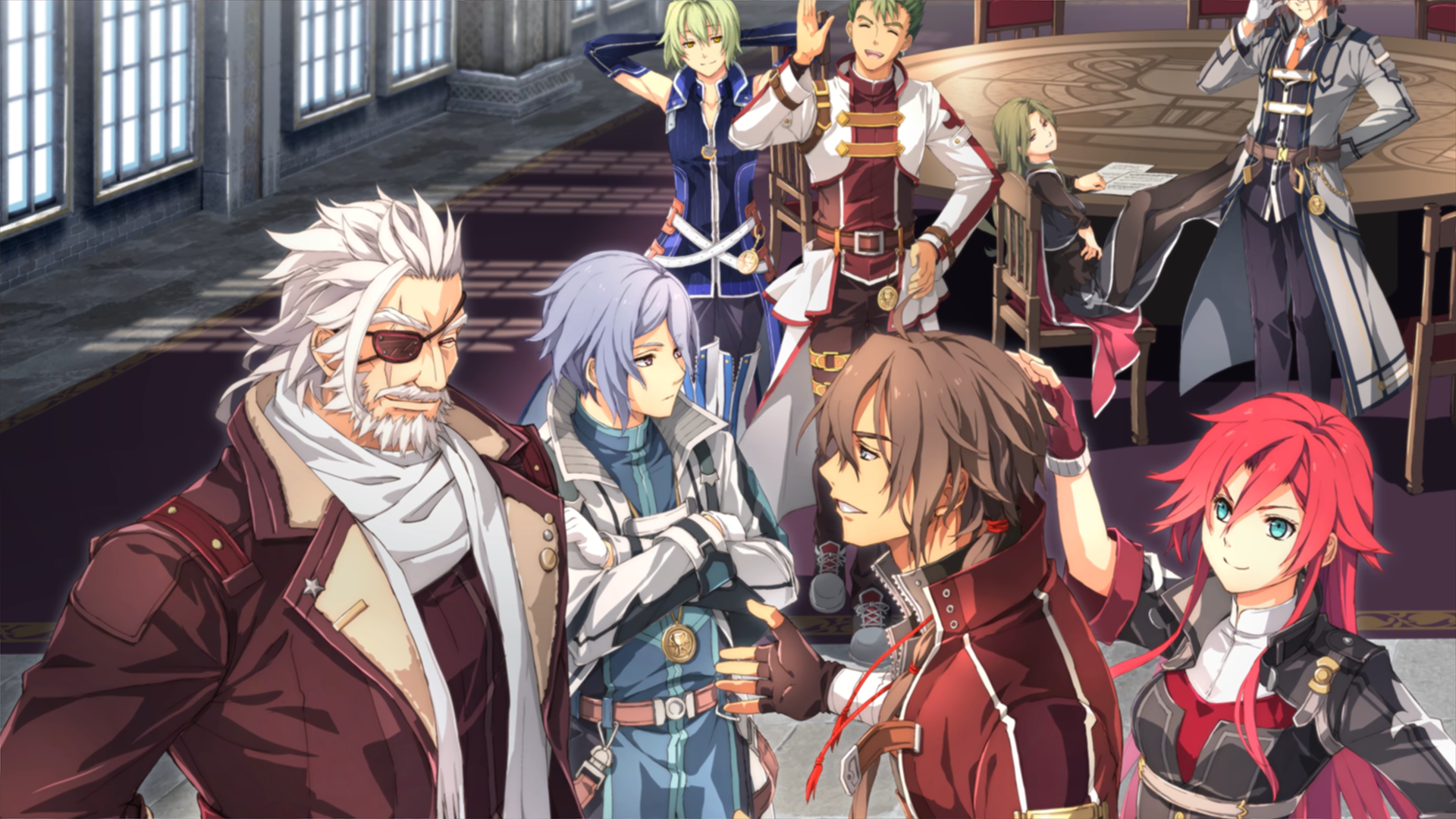
To give one final ear to potential objections while on the topic of other titles in the series, let us suppose that Daybreak’s defenders choose to abandon the notion that it was intended to be “more mature” and liken the supremacists to those villains clearly intended to just be pure evil in other entries. The big example would be the final villain of Trails from Zero, Joachim Guenter, a strong counter example given I see Zero as the series’ magnum opus thus far. Can we exonerate Calvard’s writing by treating the supremacists the same as Joachim and the D∴G Cult? No, absolutely not. Aside from the fact that Joachim simply has more lines in the narrative, including documents covering his motivations which you can view in the Sun Fort information terminals (hence coming to understand him way better than say, Edmond), the Cult plays a major thematic purpose in the story. A huge element of Zero’s narrative is that every chapter gradually brings the Special Support Section into contact with darker and darker sides of Crossbell, from local gangs to corrupt politicians and more. When the D∴G Cult is finally revealed in the last chapter it is a ‘surprise’ to be sure, but it’s also not ‘surprising’ because the game has been building up the city’s rot to the point where you can believe that this terrible clandestine society would find room to thrive in it.
In Daybreak however, the white supremacists are outright stated to be in the setting fairly early and come up roughly once per chapter from then on, but whatever impact they have on the story is almost entirely told rather than shown. The only true ugly sides of Calvard we get to see are in Oración and Edith’s Blacklight District, with the rest of the story just being about how Almata, who themselves admit that racial politics are irrelevant for them, uses the Geneses to terrorize an otherwise hunky-dory country. If anything the game promises a deeper and more mature story which tackles a real-life issue, only to focus all its efforts on Almata and expects a vicarious condemnation of the supremacists so they don’t actually have to explore the issue directly. If the story were really interested in having this conversation, so much of the supremacists’ screen time wouldn’t be buried in side content in one chapter. Sure you could argue that the supremacists feed the thematic goals of Almata spreading fear, but the goal of spreading fear is so broad that you could easily imagine the mafia finding another way to spread terror without their funding, or just finding another donor. Creil Village could have had any demographic distribution at all, and nuking it would have had largely the same impact on the country’s morale. In other words, the white supremacists are completely disposable as they are now. Zero’s D∴G Cult is a perfect culmination of everything its story set out to explore, while Daybreak’s white supremacists are just popular politics bolted onto the side of a greater threat and could have been almost anything else.
IV: Religion as the Key to Racial Unity?
At this juncture I was certain that there was no hope for Daybreak, and that there was no way you could find a constructive angle to take. But just when my analysis was at its most bleak, I found nothing short of a miracle from God Himself (no really, I came up with this while reflecting on it during Sunday Mass). There were two other details within the game which showed promise for expanding the racism subplot which I have yet to examine here. The first one being a throwaway line by Aaron about how he accepts that Heiyue is part of the problem when they counterattack white supremacist terrorists. This points to the deeper truth that racial conflict is a cycle of violence, where racial hostility creates a self-fulfilling prophecy in which constant persecution and counter-persecution proves prejudiced assumptions about the out-group right, and the story could have used this to explore a narrative about forgiveness and stopping the cycle of hate. Unfortunately Heiyue never takes any action of the sort over the game’s runtime, and Aaron’s comment ultimately goes unused as a glimmer of maturity buried under rampant immaturity.
The other detail is the presence of the Septian Church in Calvard, as while some of the dialogue by the clergy reinforces the game’s anti-conservative rhetoric there’s also evidence of racial harmony being promoted positively, particularly in the conversations that children from different backgrounds have around the churches where they actively take interest in learning about their cultural differences and sharing their own culture. At first, beautiful though these conversations were, I found this to be nothing more than a saccharine fantasy which ignores the fact that many cultures hold fundamentally different values, most of which often stem directly from religion. The idea that these children live in a world where their radically different backgrounds would instantly get along with no concerns from their parents seemed very unrealistic, especially in light of the true modern France where irreconcilable religious differences are a big source of the problem (between the Catholics, Muslims, and Secularists alike, in all directions).
In order for these cultures to coexist peacefully there needs to be some kind of animating spiritual narrative that the native Calvardians, Easterners, and Central Easterns all collectively agree upon which would transcend their differences and allow them to compromise. But here I realized that I was letting the surface level parallels to reality do too much of the talking, and though it would be very tempting to suggest the Central Easterners are merely fantasy Muslims I realized the facts are much different. The Easterners and Central Easterners refer to Aidios the Sky Goddess by different names but Daybreak makes it clear that they are all valid practitioners of the Septian faith, and this completely recasts them as more similar to the 23 valid Catholic rites outside the Roman one than they are to Muslims (plenty of those rites are actually middle eastern by the way, like the Armenian Catholic Church). There IS a cultural and spiritual link between the disparate people of Calvard through which harmony is possible, and in that moment I found the game to accidentally be not a propaganda piece for the failing secular global project, but a case for the return of Christendom.
Christendom in the simplest terms describes a state of civilization where multiple different political polities exist within a united Christian ordering of society, which effectively creates a sort of religious super-polity. This phenomenon arguably existed in both the Roman and Carolingian empires to some extent, but is most famous for directing the spirit of the high middle ages. The beating heart behind Christendom is the idea that despite political differences, the peoples of the involved nations placed their Christian faith before anything else in determining who was an ally, in lieu of any notions of race or ethnicity. While medieval Europe unfortunately found themselves at odds with each other thanks to the feudal warrior classes seeking outlets for their skills, there were periods of relative peace and cooperation spurred on by notions of Christian unity. This was especially true for the Crusades and Reconquista eras of this time period, where higher purpose helped (if not always successfully) to put those feudal warrior energies towards efforts to defend the innocent and fight back invasions from beyond the bounds of Christendom. This phenomenon disappeared after the Protestant Revolution and the Enlightenment changed local cultures to be more united along national lines, which of course eventually birthed the modern concepts of race, ethnicity, and nationality we know today.
While Christendom certainly didn’t erase the differences and conflicts between the various Christian cultures of the high middle ages it did at least provide a strong foundation for international cooperation, and applying the same concept in the form of “Septiandom” to Zemuria helps make the racial harmony we see so much more realistic. Of course it makes sense that these various cultures would get along when crammed into the same country, because for all their differences they have a shared spiritual foundation acting as a bridge which helps them learn about, understand, and even share their more particular customs amongst themselves. This also has the handy effect of recasting all the white supremacists as heretics, thus providing an extra dimension to explain their widespread disapproval by society at large. Heck, the church’s black ops even go hunting for Edmond Auclair’s head in the game itself, albeit that probably had more to do with funding Almata. That still doesn’t absolve the game from not putting any effort into fleshing them out as an antagonistic force… but it’s at least more compelling. And considering that one of Trails’ major thematic ideas is that of a medieval world which technologically advanced way too fast, it’s actually very consistent to depict a scenario where technology advanced faster than religious division did and international spiritual unity was maintained.
Much as I love this interpretation and genuinely feel it makes Calvard more interesting, this is in fact just me ballooning up small details to sizes the developers probably never intended. At the end of the day the game does seem like it’s operating under the false assumptions of absolute interchangeability between peoples and the triumph of secularism. For Heaven’s sake, the biggest moment of racial unity in the whole story is arguably the Tharbad Film Festival, which also happens to be one of the most erotic sections of the whole story. Truly, nothing could be more 2024 than big media corporations like Vegas Films telling us we can all transcend our differences if we come together and share in being degenerates… Like something so base could ever solve society’s problems!
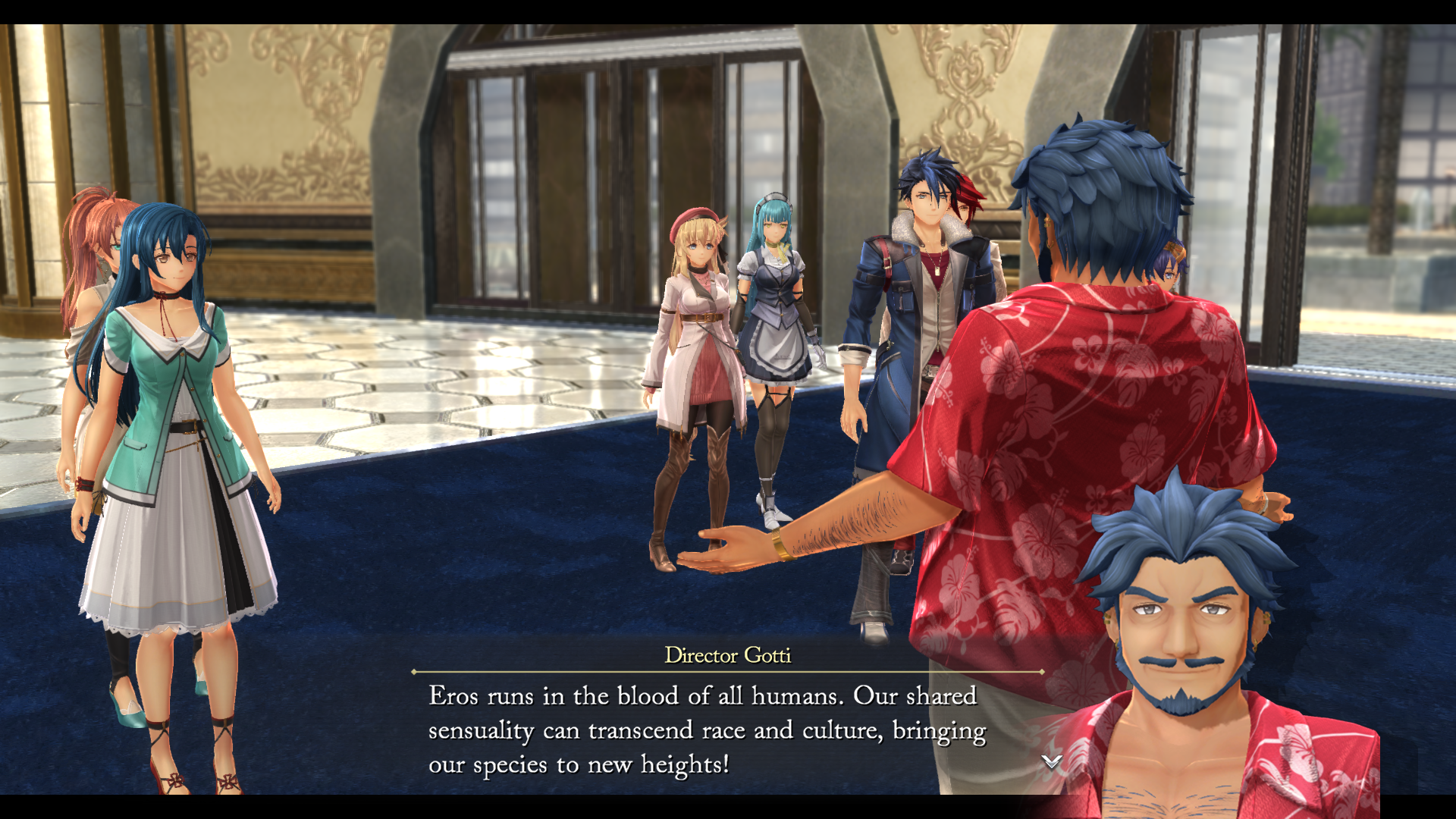
V: Conclusion
Here at the end of this long and winding examination, I leave you with this summary: The racial politics of Trails Through Daybreak are a step down in every way from the series’ previous handling of sensitive political matters, and ultimately is nothing more than a poorly written sideshow rooted in the vile lies that liberal elites spread about conservative people of European descent. White supremacy is wrong, and the white supremacists in the story are wrong to behave as they do, but in the context of a piece of interactive fiction published in the west in 2024 this topic is alarmingly mishandled and can in no way be applied to the real world unless you engage it with a massive dose of perspective on the true state of race relations in the west. There are small glimmers of nuance buried in the quiet corners of Calvard which can recast these themes in a more productive and interesting light, mostly revolving around the Septian Church continuing to be the most unfathomably based thing to ever happen to the JRPG genre, but I’m not so prideful as to pretend I can force this interpretation to be everyone’s canon. Whether you agree or disagree with my assessment I thank you for having the patience to hear my thoughts out to the end. If my reinterpretation of Calvard’s racial harmony gives you the ability to engage with the game more comfortably, or even just presents a compelling idea to add to your own reading of the Trails canon, I’m happy for you.
And if you lament that this kind of peace doesn’t exist in today’s world, we had something like it in our world’s past and we could still have something like it in the future. The only question remaining for you is…do you have the courage and humility to recognize the God who could make such a future come to be?
